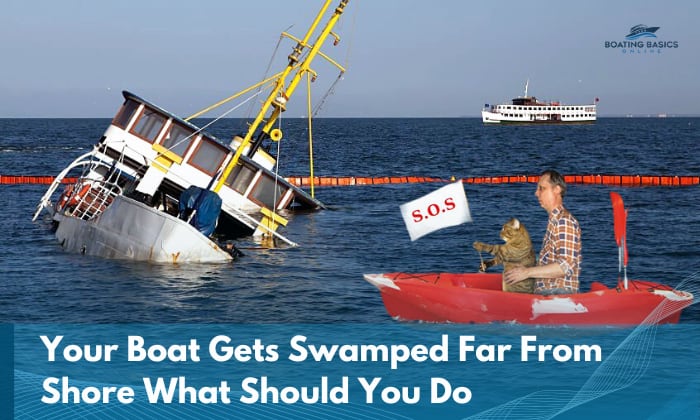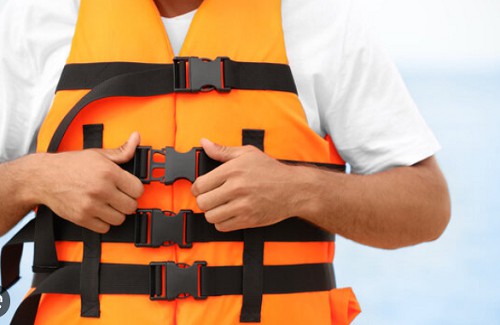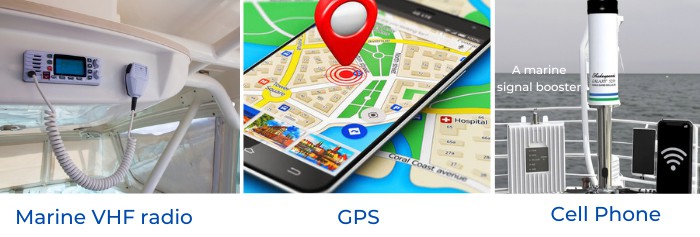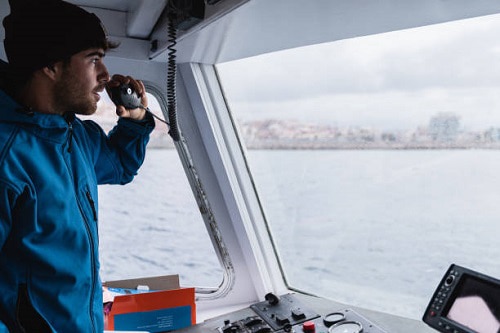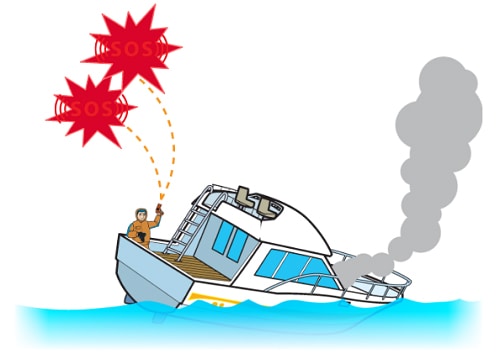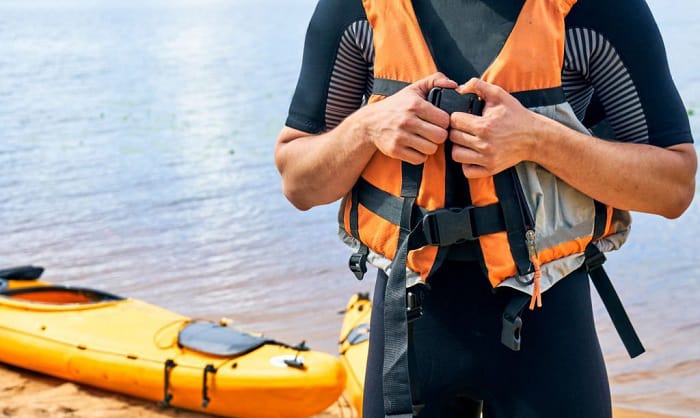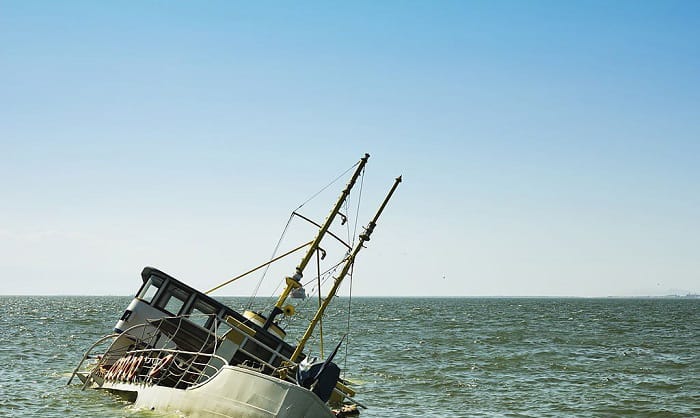As a responsible boat operator, you should know what to do in any kind of emergency you’re thrust into. It’s good that you’re taking the time to know the answer to a scenario like “Your boat gets swamped far from shore what should you do?”
Almost all the steps you need to take involve prioritizing everyone’s safety. This means analyzing the situation, stabilizing the boat, putting on safety equipment, communicating with the coast guard, and sending distress signals.
Table of Contents
Understanding the Situation
When we say that a boat got swamped, it means it has taken on enough water. It’s compromised enough to be considered unstable, no longer as buoyant, and has a chance to sink. It’s not floating on its side or has turned over, which is already considered a capsized vessel.
It’s not necessarily a situation that involves a breach in the hull. However, it can get severe enough to leave you no choice but abandon the vessel before it sinks entirely.
Preparing for the Worst
Even before you begin to understand your specific situation, you should already be taking active steps to ensure you and your passengers will get out of this situation scot-free.
1. Put on Safety Equipment
Naturally, you need to wear a PFD posthaste if you haven’t already put one on.
Keep in mind that wearing a lifejacket remains the safest way to float on water, so you really shouldn’t have any qualms about putting one on the moment you go onboard. Gather all the throwable flotation devices you have onboard and keep them within arm’s reach of passengers to assist in emergencies.
Keep a tally of your passengers as you do so, and communicate the importance of wearing a PFD and your action plan.
Another safety equipment you should activate is your boat’s EPIRB (Emergency Position Indicating Radio Beacon). Most can be turned on with the push of a button and will promptly send signals that will alert authorities and nearby vessels about the accident you were in.
It needs to be registered, though. Follow the instructions on this link to that if you haven’t done this already: https://tinyurl.com/yuajuz8r
Other than that, you should also communicate and know verify your exact location via reliable gadgets like:
- Marine VHF radio – know the basic signals like MAYDAY, PAN-PAN, and SECURITE. You can learn how to use it by viewing this short video tutorial:
- GPS – used to aid in your navigation and pinpointing your exact location.
- Cell Phone – consider getting a marine signal booster so you won’t completely cross it out as an option for communication even if you’re far from shore.
Immediate Actions
Besides wearing a PFD, these are the two actions you shouldn’t delay doing.
1. Assessing the Situation
Finding yourself in this scenario can be daunting. Still, you should do your best to stay calm as you’ll need to assess the gravity of the situation. Not all boats that get swamped are lost, but saving your boat should come secondary to keeping yourself safe.
This is why you should establish whether you can stabilize the boat and control damage. For one, confirm the damage the boat sustained or what caused it to be swamped.
Maybe, one of the safety equipment just didn’t kick in properly? Can the bilge pump still keep up, or was it on, to begin with? Most boats with an open bow tend to the swamp, but a bilge pump can save the vessel if operators simply don’t forget to turn it on.
Or, perhaps, the drain plug became stuck? If that’s the case, you most likely won’t have enough time to get it unstuck.
2. Stabilizing the Boat
Make sure to start the bilge pump as soon as possible, as it’s designed to handle small hull breaches. It should buy you time, and even more, if you grab a bucket, scoop water, and do your best to minimize the flooding. Other than those two, you can perform no other viable actions to stabilize your boat.
Calling for Help and Signaling
Other than the EPIRB, there’s no shortage of other distress signals and communication tools you can use.
1. Radio Communications
Usually, once you send a standard MAYDAY signal, you also have to reveal additional information that will be useful to your rescuers. Start with the following:
- Pronounce your vessel’s name or call sign.
- Reveal details about your boat’s position.
- Explain the nature of your situation
- Confirm that you are indeed seeking aid
- Tell the number of passengers you have if there are any
Always remember the radio frequency for the US Coast Guard, which is VHF-FM Channel 16 (156.8 MHz). You can also just dial 911, assuming you maintain a phone signal.
2. Visual Distress Signals
Here are some visual distress signals you can employ:
- Use USCG-approved red flares or orange smoke signal flares, or parachute flares.
- The same goes for red flags.
- Turn on your electric distress signal light.
Survival Strategies
Below are a few guidelines that could save you and your passengers during stranded or swamped situations.
1. Maintaining Personal Safety
- Never take off your PFD.
This should be self-explanatory. I need to stress the importance of maintaining your lifejackets since availability is just one-half of the equation. You have to ensure it can save your life once you put it on!
- Conserve your energy and stay calm.
Approach your situation with a mindset that helps will eventually come, and you’ll need to save energy once that opportunity arrives. Stop treading on the water; just float.
This accounts for a scenario where you weren’t able to save food or drink (good for you if you do manage to do this) and are facing the possibility of spending the night floating on the water or in whatever space your capsized boat can still provide.
- Do everything possible to get on the boat or out of the water.
This is especially true once night comes and you’re in a place where the water temperature drops to near zero degrees (Celsius). If that’s the case, hypothermia can kill you in minutes! Don’t leave your boat, though, as I’ll explain below.
Overall, this should be your primary concern and the first answer you must be mindful of when asking, “What happens when a boat capsizes?”
2. Seeking Assistance and Staying Visible
Continue to use whatever communication tool you have available and send distress signals. The most effective way to stay visible is to always stay close to the boat.
Yes, this applies even if there’s no possible way for you to board or right your vessel anymore. Once a boat capsizes and floats away, you’ll be in deep trouble as you’re less likely to be seen by potential rescuers – unlike your boat, that’s far bulkier.
Reasons Why Your Boat Gets Swamped Far from Shore
Remember that any of the following factors can lead to a swamped boat:
- Overloading
- Unexpected waves and winds
- Incorrect weight distribution
- Wrong anchoring practices
- Safety and drainage equipment not working properly
- Failure to maintain your boat’s watertight envelope (i.e., the hull and deckhouse combined)
Tips to Prevent Off-shore Swamping
It’s always a good thing that even if a small craft capsizes, everyone survives. However, you can always find a step or two to keep it from happening in the first place. Start with these pointers:
- Monitor your through-hull fittings. Plastic can last for decades but degrades due to UV rays and saltwater. Use more durable materials like stainless steel.
- Check the scuppers for blockage, as water can accumulate in your boat quickly and cause swamping. Clear out any debris that’s preventing water from flowing out properly.
- It’s always prudent to regularly maintain your ship, particularly the vessel’s watertight integrity, before every outing.
- Maintain the bilge pump. Check that it’s working properly before operating your boat. It should be free from standing water.
Conclusion
Did you find the answers to “Your boat gets swamped far from shore what should you do?” helpful and illuminating? These tips are standard topics in any boater safety course and USCG standard procedure.
They’ve also been honed from past accidents, so I can’t really come up with a better mix of guidelines and analysis of possible issues and courses of action. Following all of them will only raise your odds of survival in situations like these that can become dire in minutes.

“My intention from the first day establishing Boating Basics Online is to provide as much help as possible for boaters who want to experience a first safe and convenient trip. So feel free to join us and share your beautiful journeys to the sea!”

